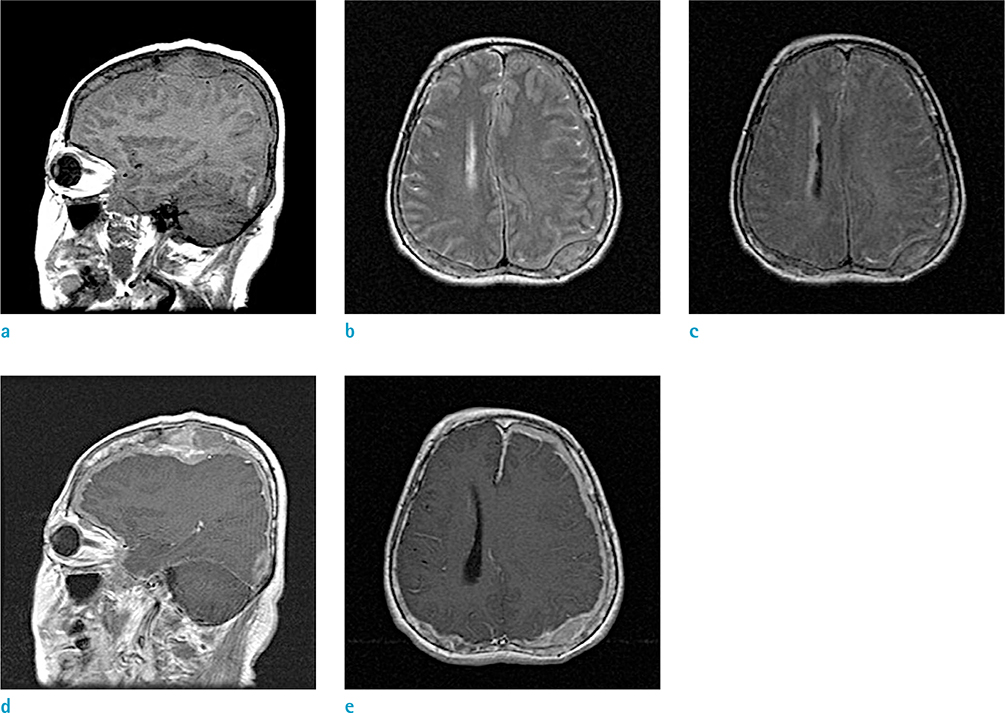Investig Magn Reson Imaging.
2015 Dec;19(4):252-255. 10.13104/imri.2015.19.4.252.
A Rare Case of Diffuse Pachymeningeal Involvement of Multiple Myeloma
- Affiliations
-
- 1Department of Radiology, Kyung Hee University Hospital, Seoul, Korea. euijkim@hanmail.net
- 2Department of Neurosurgery, Kyung Hee University Hospital, Seoul, Korea.
- KMID: 2151774
- DOI: http://doi.org/10.13104/imri.2015.19.4.252
Abstract
- Intracranial involvement in multiple myeloma patients takes up around 1%, and is usually known to be present in the parietal bone or skull base in cases of skull vault involvement, while it presents in the dura and parenchyma in cases of intracranial involvement. Primary pachymeningeal invasion is even rarer with extremely rapid progression and very poor prognosis. It is our intent to report a case in which we had to differentiate multiple myeloma with other metastatic tumors, lymphoma, and leukemia with intracranial involvement. Our patient showed an osteolytic lesion of the skull with dural involvement and subdural mass formations.
Keyword
Figure
Reference
-
1. Terada T. Multiple myeloma presenting as an intracranial plasmacytoma: a case report. Cases J. 2009; 2:9110.2. Cerase A, Tarantino A, Gozzetti A, et al. Intracranial involvement in plasmacytomas and multiple myeloma: a pictorial essay. Neuroradiology. 2008; 50:665–674.3. Munshi NC, Longo DL, Anderson KC. Plasma cell disorders. In : Longo DL, Fauci AS, Kasper DL, editors. Harrison's principles of internal medicine. 18th ed. New York: The McGraw-Hill Education;2011. p. 936–944.4. Schluterman KO, Fassas AB, Van Hemert RL, Harik SI. Multiple myeloma invasion of the central nervous system. Arch Neurol. 2004; 61:1423–1429.5. Pizzuti P, Pertuiset E, Chaumonnot F, et al. Neuromeningeal sites of multiple myeloma: 3 cases and review of the literature. Rev Med Interne. 1997; 18:646–651.6. De Blay V, Misson N, Dardenne G, Dupuis MJ. Leptomeningeal myelomatosis mimicking a subdural haematoma. Neuroradiology. 2000; 42:735–737.7. Roddie P, Collie D, Johnson P. Myelomatous involvement of the dura mater: a rare complication of multiple myeloma. J Clin Pathol. 2000; 53:398–399.8. Moran CC, Anderson CC, Caldemeyer KS, Smith RR. Meningeal myelomatosis: CT and MR appearances. AJNR Am J Neuroradiol. 1995; 16:1501–1503.
- Full Text Links
- Actions
-
Cited
- CITED
-
- Close
- Share
- Similar articles
-
- Liver Involvement of Multiple Myeloma Mimicking Intrahepatic Cholangiocarcinoma: A Case Report
- A Case of Diffuse Normolipemic Plane Xanthoma Associated with Multiple Myeloma
- Meningeal and Cerebral Involvement of a Plasmacytoma in an IgG Multiple Myeloma Patient: Case Report
- Diffuse Normolipemic Plane Xanthoma with Multiple Myeloma
- A Case of Diffuse Normolipemic Plane Xanthoma Associated with Multiple Myeloma




